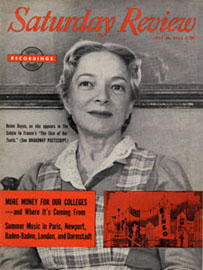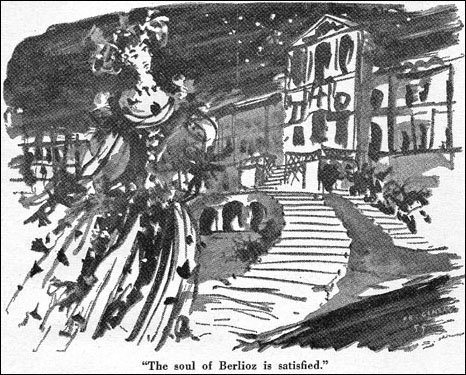By
Herbert Weinstock
© Herbert Weinstock
Published in Saturday Review Recordings, 30 July
1955![]()

THE STARS shone in the Paris sky. The moon was there, and the cool air promised to become a little chilly. The audience assembled in the great quadrangle of the Cour Carrée of the Louvre grew audibly impatient as the scheduled hour for the performance came and went. At last a man appeared on the stage above the orchestra to announce that because of the “douceur de la nuit” it had been decided to wait for complete darkness before beginning: then the audience might enjoy the spectacle at its best. This explanation was received with applause, and we settled back again to face the west interior façade of the Old Louvre. There, behind the orchestra and the wide stage, the curving double staircase grandly swept up to the chief entrance beneath the central tower, from which bright banners hung, moving occasionally in the freshening breeze. Thousands of us had come to see what the Comité Officiel des Fêtes de Paris and the Marquis George de Cuevas had made of Berlioz’s “Roméo et Juliette.” What they had made of it proved to be an opera-ballet of unparalleled pomp, theatrical effectiveness, and visual magnificence.
The forces involved in this integral presentation of the wonderful Berlioz score were the Grand Ballet du Marquis de Cuevas, the Choruses and Orchestra of the Concerts Colonne, Michel Roux (bass, as Friar Laurence), Pamela Bowden (contralto, as Nurse to Juliet), and Gérard Friedmann (tenor, solo in the Queen Mab scene). The danced parts of Romeo and Juliet were taken by George Skibine and Marjorie Tallchief; those of the spirits of the lovers by George Zoritch and Yvonne Meyer; that of Queen Mab by Genia Melikova; and that of the chief entertainer at the “Grande Fête chez les Capulets” by Serge Golovine.

The program reminded us that Berlioz himself, writing in 1859, said that “Roméo et Juliette” was neither an opera in concert form nor a cantata. He had explained that if the celebrated scenes in the garden and the cemetery, the lovers’ dialogues, the soliloquies of Juliet, and Romeo’s impassioned monologues were not set for singing, and if the dialogues of love and despair had been confided to the orchestra alone, he had had his reasons. "Dialogues of this sort having been treated vocally a thousand times by the greatest masters, it was both prudent and fascinating to attempt another mode of expression,” he wrote.
“Prélude—Combat—Tumulte,” and beneath that starry Paris sky male Capulets and Montagues swept up and down the curving steps in sword-play. The mood was set at once by the piercingly lyric presence and movements of Skibine as Romeo. The fatal stabbing of Tybalt announced tragedy. In the musically superb “Tristesse de Roméo,” Skibine again excelled. Marjorie Tallchief briefly emerged, a childlike Juliet, high up before the palace doors; and Pamela Bowden as the Nurse sang "Premiers transports” almost as movingly as Gladys Swarthout sang them under Toscanini some years ago. With a burst of lights in the palace itself the “Grande Fête chez les Capulet” surged up, the staircases and garden-stage blazing with color and swirling with panoply. Golovine danced a striking grande variation, which led into a farandole by the servants. The masked Romeo confronted Juliet, was recognized by her protectors, and fled. Juliet was formally affianced to young Paris.
On the vast stage of stairs and garden Tallchief and Skibine beautifully danced the “Scène d’amour.” Friar Laurence married them. When Juliet, having taken the sleeping potion, lay motionless, George Zoritch and Yvonne Meyer, costumed like the lovers, moved into the Queen Mab scene. Here the story became vague and the costuming fell out of tone—showing perhaps the influence of the Folies-Bergère (which I had also noted at the Opéra in “Les Indes galantes”). Luckily, this was the special moment for Martinon, the tenor, the orchestra, and the excellent choruses. Not even the vagaries of the loudspeakers could dampen the wonders of Berlioz’s music.
After a blackout, the “Cortège funèbre” came forth, an ecclesiastical and mourning procession of magnificent solemnity. On a bier, Juliet’s fragile body was born down one curve of the double stairs and placed downstage center. When she had been left alone, only the edges of her white dress moved in the breeze. Here the fact that the floor of the stage was a dozen feet above the audience eye-level—a detriment to the fine points of dancing—added to the moving solemnity. Skibine’s realization of Romeo’s despair and suicide was that of a truly great dancer. The double death was followed by a remarkable moment when Michel Roux as Friar Laurence stood high on the end of the bier (on which Juliet, and beside which Romeo, lay sprawled), singing while the Montagues and Capulets and their entire entourages clustered round. The magic of Berlioz and of fine singing and expert spectacular staging were woven together. And at the end the audience gave enthusiastically the tribute of prolonged applause. Then as the lights went out the Cour Carrée was slowly emptied. If the soul of Hector Berlioz still haunts the city he loved and fought, it must have been well satisfied.
![]()
* This article has been transcribed from a
contemporary copy of the Saturday Review Recordings, 30 July 1955, p. 36, in our own collection. We have preserved the author’s original spelling,
punctuation, and syntax.![]()
We have not been able to contact the editor of this issue of the Saturday Review Recordings, which has ceased publication.
![]()
The Hector Berlioz Website was created by Monir Tayeb and Michel Austin on 18 July 1997; this page created on 1 April 2009.
© Monir Tayeb and Michel Austin. All rights of reproduction reserved.
![]() Back to Original Contributions page
Back to Original Contributions page
![]() Back to Home Page
Back to Home Page
![]() Retour à la page Contributions Originales
Retour à la page Contributions Originales
![]() Retour à la Page d’accueil
Retour à la Page d’accueil